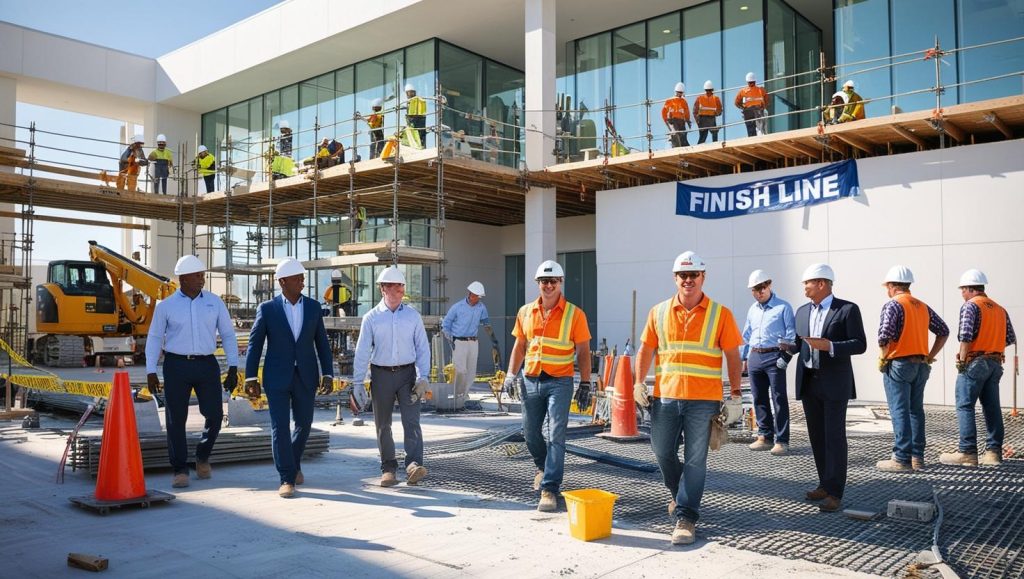For anyone deeply embedded in a construction project, few phrases are as eagerly anticipated as “Substantial Performance.” It signals the light at the end of the tunnel, the pivotal point where a project is deemed largely complete and ready for its intended use.
This milestone triggers critical financial processes, most notably the release of the basic holdback, and initiates various lien and warranty periods.

Yet, for many stakeholders from the architects drawing up plans to the contractors building them, and the owners anticipating occupation this crucial finish line can often feel more like a shifting mirage, fraught with legal complexities, practical ambiguities, and the potential for costly disputes. At RForm.ca, we regularly speak with architects, engineers, contractors, and owners across Canada from our home base, to the bustling project sites in Ontario, Alberta, and beyond. A common and persistent challenge echoes through these conversations: accurately defining, mutually agreeing upon, and legally certifying substantial performance is rarely straightforward, regardless of the project’s size or complexity.
The “Formulas” of Substantial Performance: More Than Just Numbers
While there isn’t a universally numbered “Formula 1, 2, 3” enshrined as a formal legal term across all Canadian jurisdictions, many provinces, including Ontario, employ specific legal criteria and quantifiable thresholds within their Construction Act (formerly the Construction Lien Act) to determine substantial performance.
In Ontario, for instance, a project reaches substantial performance when it is “ready for use or is being used for the purpose for which it was intended” and when the work remaining to be done or corrected is so minor that the cost to complete or rectify these deficiencies is no more than:
Ontario Formula:
- 3% of the first $1,000,000 of the contract price
- 2% of the next $1,000,000 of the contract price
- 1% of the balance of the contract price
This “formula” provides a seemingly clear, percentage-based benchmark. However, even with these numbers, the practical application often leads to significant headaches.
In contrast, provinces like British Columbia, under their Builders Lien Act, tie substantial performance to the issuance of a formal Certificate of Completion or the date of completion/abandonment of the head contract. This then triggers a critical 55-day holdback release period. While the precise legal definitions and procedural requirements vary from province to province, the underlying challenges in determining, certifying, and agreeing upon substantial performance remain remarkably universal.

The Headaches and Heartaches: Why Substantial Performance is a Pain Point
- The Subjectivity Trap: Despite legal definitions and percentage-based financial thresholds, the very notion of a project being “ready for use” or remaining deficiencies being “minor” often falls prey to subjective interpretation. What might be deemed a trivial punch-list item by a contractor eager for holdback release could be viewed as a critical flaw preventing occupancy by an owner. Imagine a university campus project where a crucial security system still has minor bugs, or a municipality’s new recreation centre with slight water pressure issues. These seemingly small details can lead to heated debates, stall final payments, and inject significant uncertainty into project closeout.
- Ready For Take Over (RFT): In the last few years, with the introduction of the CCDC Stipulated Lump Sum 2020, the contract that the term “Substantial Performance” has been augmented with the term Ready-for-Takeover (RFT) . The introduction of Ready-for-Takeover aims to provide greater clarity and better align contractual completion with the owner’s ability to actually use and occupy the work. It addresses situations where a project might meet the legal definition of substantial performance but may not yet be fully ready for the owner’s intended use from a practical, operational perspective.
- Financial Tightropes and Cash Flow Crises: Substantial performance is the green light for releasing the basic holdback, typically 10% – 15% of the contract value. For contractors, this represents vital cash flow, often essential for paying subcontractors and suppliers, or even for staying solvent on ongoing projects. Delays in certification can create acute financial pressures, impacting their ability to start or finish new work. For owners, the holdback serves as a crucial financial security blanket, protecting their investment against incomplete work, future deficiencies, or outstanding liens. Any ambiguity or delay in the certification process directly impacts financial timelines, creating tension and potentially triggering legal actions if statutory lien periods are missed or holdbacks are improperly released.
- Communication Breakdowns and Mistrust: The substantial performance process relies heavily on seamless, transparent communication between the contractor, owner, and the payment certifier (most commonly the architect or engineer). Misunderstandings about the criteria for readiness, incomplete or delayed deficiency lists, or slow response times from any party can easily derail the entire process.
- Warranty & Liability Shifts: The certified date of substantial performance is more than just a financial trigger; it often marks the commencement of warranty periods for materials and workmanship. It can also shift responsibilities for site security, maintenance, and utility costs from the contractor to the owner.
RForm.ca to the Rescue: Navigating the Finish Line with Confidence
This is precisely where robust, purpose-built contract administration software like RForm.ca transforms the substantial performance pain point into a smooth, transparent, and legally compliant process. Here’s how RForm.ca empowers all stakeholders:

- Centralized, Immutable Digital Documentation: RForm.ca provides a single, secure source of truth for all project communications, documents, and deficiency lists. Every RFI, change order, site instruction, payment application, and progress report is digitally logged, time-stamped, and linked to the relevant contract elements. When it’s time to assess substantial performance, all necessary information – a complete audit trail – is at your fingertips, readily accessible and verifiable, drastically reducing subjective arguments and bolstering your position with concrete, compliant data.
- Streamlined, Collaborative Deficiency Tracking: Our software empowers architects and engineers to easily log deficiencies directly from the site, add photos, assign responsibilities to specific contractors or trades, and monitor completion status in real-time. This transparent system ensures all parties are aware of outstanding items, their resolution progress, and their associated costs, facilitating an objective agreement on when the “cost to complete” criteria are definitively met. This process is fully auditable, leaving no room for ambiguity.
- Crystal-Clear Financial Overviews: By integrating progress payment tracking with holdback management, RForm.ca provides a real-time, transparent financial picture of the project. Parties can effortlessly visualize the value of work completed versus the estimated cost of remaining deficiencies. This clarity is invaluable during negotiations, supporting accurate holdback calculations and fostering a shared understanding that simplifies the agreement process and ensures fair and timely financial settlements.
- Enhanced Collaboration & Proactive Transparency: All authorized project stakeholders – owners, architects, engineers, and contractors – can access relevant, up-to-date information through RForm.ca’s secure platform. This shared, live dashboard fosters unparalleled transparency and facilitates proactive communication. In-app messaging, shared document annotations, and centralized communication logs minimize misunderstandings and build a foundation of trust, transforming what could be a contentious closeout into a smooth, collaborative transition to project completion and warranty phases.
Substantial performance doesn’t have to be a source of stress or a trigger for disputes. With robust contract administration software like RForm.ca, you can ensure that this critical finish line is clearly defined, mutually understood, and achieved with confidence and legal compliance, allowing all parties to close out projects efficiently and move forward to the next exciting venture.

